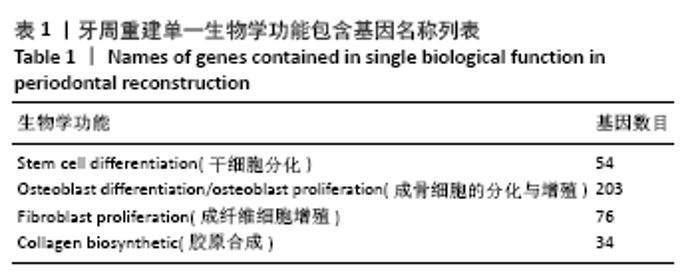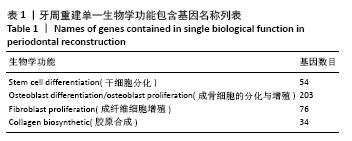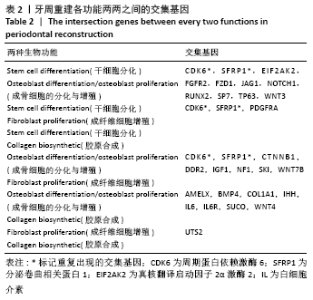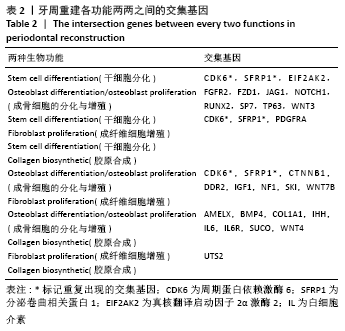Chinese Journal of Tissue Engineering Research ›› 2022, Vol. 26 ›› Issue (2): 253-259.doi: 10.12307/2022.041
Previous Articles Next Articles
Selection of key genes related to biological functions and regulation pathway in periodontal reconstruction
Feng Dongfei1, 2, He Hongxu1, Xie Qi1, Zhang Lili2, Zhou Hui1, Li Wei1
- 1Harbin Children’s Hospital, Harbin 150010, Heilongjiang Province, China; 2Harbin Stomatological Hospital, Harbin 150016, Heilongjiang Province, China
-
Received:2020-10-19Revised:2020-10-24Accepted:2020-12-07Online:2022-01-18Published:2021-10-27 -
Contact:Feng Dongfei, Harbin Children’s Hospital, Harbin 150010, Heilongjiang Province, China; Harbin Stomatological Hospital, Harbin 150016, Heilongjiang Province, China -
About author:Feng Dongfei, MD, Chief physician, Harbin Children’s Hospital, Harbin 150010, Heilongjiang Province, China; Harbin Stomatological Hospital, Harbin 150016, Heilongjiang Province, China -
Supported by:a grant from Harbin Science and Technology Bureau, No. 2016RAXYJ082 (to FDF)
CLC Number:
Cite this article
Feng Dongfei, He Hongxu, Xie Qi, Zhang Lili, Zhou Hui, Li Wei. Selection of key genes related to biological functions and regulation pathway in periodontal reconstruction[J]. Chinese Journal of Tissue Engineering Research, 2022, 26(2): 253-259.
share this article
Add to citation manager EndNote|Reference Manager|ProCite|BibTeX|RefWorks
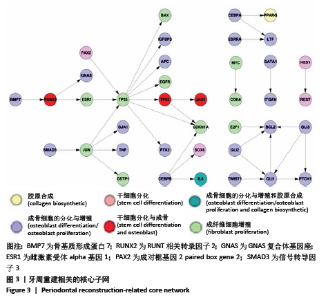
2.2.2 生物功能的交集基因 通过表2可见,干细胞分化、骨组织改建及成纤维细胞增殖三者间有2个交集基因,分别是CDK6和SFRP1。 2.3 调节基因的上下游通路关系 使用上述生物学过程内包含的全部基因映射到背景调控网络中,直接相连基因形成的子网包含了45个基因,37条调控关系,文章认为这个网络是与牙周重建密切相关的核心子网,见图3,不同颜色代表不同的生物学功能。 基于核心子网使用广度优先算法挖掘了网络内所有入度为0的点到出度为0的点的所有通路,一共找到了34条通路,这些通路内最长的包含6个基因,最短的包含3个基因。其中长度大于3的通路中作为上游调控牙周重建的基因中出现频次较高的有3个一级基因:骨形态发生蛋白7、信号转导因子3(SMAD3)和核转录因子2(PAX2);2个二级基因:RUNX2和JUN;2个三级基因:ESR1和GNAS。"
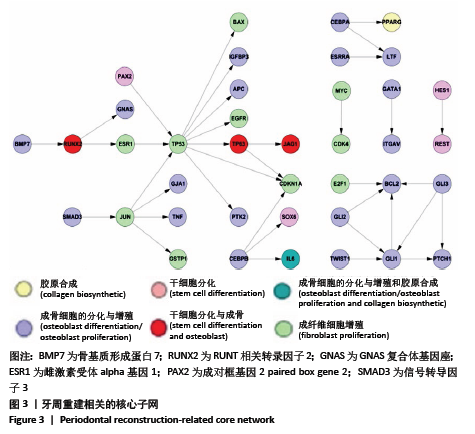
| [1] 吕雪雯,潘春玲.牙周组织工程的研究进展[J].中国医科大学学报, 2019,48(12):1132-1136. [2] Caton J, Bostanci N, Remboutsika E, et al. Future dentistry: cell therapy meets tooth and periodontal repair and regeneration. J Cell Mol Med. 2011;15(5):1054-1065. [3] PAN W, Wang Q, Chen Q. The cytokine network involved in the host immune response to periodontitis. Int J Oral Sci. 2019;11(3):30. [4] Hu L, Liu Y, Wang S. Stem cell‐based tooth and periodontal regeneration. Oral Dis. 2018;24(5):696-705. [5] Suzuki A, Horie T, Numabe Y. Investigation of molecular biomarker candidates for diagnosis and prognosis of chronic periodontitis by bioinformatics analysis of pooled microarray gene expression datasets in Gene Expression Omnibus (GEO). BMC Oral Health. 2019;19(1):52. [6] 王宝华,赵亦非,沈莉蓉,等.牙周炎组织中miRNA表达谱差异筛选及功能预测分析[J].上海口腔医学,2019,28(4):408-411. [7] 于世凤.口腔组织病理学:第七版[M].北京:人民卫生出版社,2019. [8] Li S, Liu X, Li H, et al. Integrated analysis of long noncoding RNA-associated competing endogenous RNA network in periodontitis. J Periodontal Res. 2018;53(4):495-505. [9] Wang J, Lu M, Qiu C, et al. TransmiR: a transcription factor-micro RNA regulation database. Nucleic Acids Res. 2010;38(Database issue): D119-D122. [10] Hsu SD, Lin FM, Wu WY, et al. MiRTarBase: a database curates experimentally validated micro RNA-target interactions. Nucleic Acids Res. 2011;39(Database issue):D163-D169. [11] Xiao F, Zuo Z, Cai G, et al. miRecords: an integrated resource for microRNA-target interactions. Nucleic Acids Res. 2009;37(Database issue):D105-D110. [12] Sethupathy P, Corda B, Hatzigeorgiou AG. TarBase: a comprehensive database of experimentally supported animal microRNA targets. RNA. 2006;12(2):192-197. [13] Jiang W, Zhang Y, Meng F, et al. Identification of active transcription factor and miRNA regulatory pathways in Alzheimer’s disease.Bioinformatics. 2013;29(20):2596-2602. [14] Mariko K, Kataoka Y, Junya S, et al. Non-surgical model for alveolar bone regeneration by bone morphogenetic protein-2/7 gene therapy. J Periodontolol. 2018;1(18):85-92. [15] Nedyalka V, Michelle E, Jacob M, et al. MicroRNA-1-mediated inhibition of cardiac fibroblast proliferation through targeting cyclin D2 and CDK6. Front Cardiovascular Med. 2019;6:65. [16] Andisheh-Tadbir A, Javad Ashraf M, Jeiroodi N. Expression of CDK6 in Oral Squamous Cell Carcinomas. Asian Pac J Cancer Prev. 2018;19(4):1013-1016. [17] Chen X, Zhang T, Shi J, et al. Noth1 signaling regulates the proliferation and self-renewal of human dental folliclecells by modulating the G1/S phase transition and telomerase activity. PLoS One. 2013;8(7):e69967. [18] Kujan O, Huang G, Ravindran A, et al. CDK4, CDK6, cyclin D1 and Notch1 immunocytochemical expression of oral brush liquid‐based cytology for the diagnosis of oral leukoplakia and oral cancer. J Oral Pathol Med. 2019;48(7):566-573. [19] Schiraldi C, Stellavato A, D’Agostino A, et al. Fighting for territories:time-lapse analysis of dental pulp and dental follicle stem cells in co-culture reveals specific migratory capabilities. Eur Cell Mater. 2012;24:426-440. [20] Matthews BG, Roguljic H, Franceschetti T, et al. Gene-expression analysis of cementoblasts and osteoblasts. J Periodontal Res. 2016;51(3):304-312. [21] Wu XL, Gu QH, Chen XP, et al. MiR-27a targets DKK2 and SFRP1 to promote reosseointegration in the regenerative treatment of peri-implantitis. J Bone Mineral Res. 2019;34(1):123-134. [22] 池毓坦,许春姣,孙晓娟,等.分泌型卷曲相关蛋白1及β-连环蛋白在慢性牙周炎患者牙龈组织中的表达[J].华西口腔医学杂志, 2018,36(3).257-261. [23] 杜锐,李隽,吴迎涛.SFRP1蛋白、MIF在重度牙周炎老年患者中的表达及与认知功能的相关性分析[J].上海口腔医学,2020,29(1):97-101. [24] Anusuya GS, Kandasamy M, Jacob Raja SA, et al. Bone morphogenetie proteins: signaling periodontal bone regeneration and repair.J Pharm Bioallied Sci. 2016;8(Suppl 1):S39-S41. [25] Ghuman MS, Maher A, Guilherme x, et al. Gingival fibroblasts prevent BMP-mediated osteoblastic differentiation. J Periodontal Res. 2019;54(3):300-309. [26] Rao SM, Ugale GM, Warad SB. Bone morphogenetic proteins:periodontal regeneration. N Am J Med Sci. 2013;5(3):161-168. [27] Liu WJ, Cui YJ, Wei JY, et al. Gap junction-mediated cell-to-cell communication in oral development and oral diseases: a concise review of research progress. Int J Oral Sci. 2020;12(1):17. [28] 班桂飞,陈凤,欧永富,等.HtrA1、TGF-β1及Smad3在人牙髓细胞向成牙本质细胞分化过程中的动态表达研究[J].广西医科大学学报, 2017,34(5):676-680. [29] Huang X, Liu F, Hou J, et al. Inflammation-induced overexpression of microRNA-223-3p regulates odontoblastic differentiation of human dental pulp stem cells by targeting SMAD3. Int Endod J. 2019;52(4): 491-503. [30] Liu ZH, Guo L, Li RL, et al. Transforming growth factor-β1 and hypoxia inducible factor-1α synergistically inhibit the osteogenesis of periodontal ligament stem cells. Int immunopharmacol. 2019; 75:105834. [31] Gu K, Fu Xh, Tian H, et al. TAZ promotes the proliferation and osteogenic differentiation of human periodontal ligament stem cells via the p-SMAD3. J Cell Biochem. 2020;121(2):1101-1113. [32] Shi JW, Matthias F, Andrea W, et al. Differences in RUNX2 and P2RX7 gene expression between mono- and coculture of human periodontal ligament cells and human osteoblasts under compressive force application. Orthop Craniofa Res. 2019;22(3):168-176. [33] Marconi GD, Diomede F, Pizzicannella J, et al. Enhanced VEGF/VEGF-R and RUNX2 expression in human periodontal ligament stem cells cultured on sandblasted/etched titanium disk. Front Cell Dev Biol. 2020;8:315. [34] Lee M, Arikawa K, Nagahama F. Micromolar Levels of Sodium Fluoride Promote Osteoblast Differentiation Through Runx2 Signaling. Biol Trace Elem Res. 2017;178(2):283-291. [35] Buhrmann Constanze, Bastian Popper, Aggarwal BB, et al. Evidence that TNF-β suppresses osteoblast differentiation of mesenchymal stem cells and resveratrol reverses it through modulation of NF-κB, Sirt1 and Runx2. Cell Tissue Res. 2020;381(3):83-98. [36] Shaoqin Tu, Wu JY, Chen LL, et al. LncRNA CALB2 sponges miR-30b-3p to promote odontoblast differentiation of human dental pulp stem cells via up-regulating RUNX2.Cell Signal. 2020;73:109695. [37] 逄键梁,邓天政,朱晓茹,等.c-Jun、c-Fos对人牙本质基质蛋白1基因转录调控作用的研究[J].现代口腔医学杂志,2010,24(6): 443-447 . [38] 徐畅,魏亚红,王玉敏,等.Jun家族蛋白在釉质发育中的表达及对amelogenin的调控作用[J].牙体牙髓牙周病学,2015,25(9):515-528. [39] Tang Y, Liu L, Wang P, et al. Periostin promotes migration and osteogenic differentiation of human periodontal ligament mesenchymal stem cells via the Jun amino-terminal kinases (JNK) pathway under inflammatory conditions. Cell Prolif. 2017;50(6):e12369. [40] Nagayasu-Tanaka T, Anzai J, Takaki S, et al. Action Mechanism of Fibroblast Growth Factor-2 (FGF-2) in the Promotion of Periodontal Regeneration in Beagle Dogs. PLoS One. 2015;10(6):e0131870. [41] Zhang FG, Song JG, Zhang HM, et al. Wnt and BMP Signaling Crosstalk in Regulating Dental Stem Cells: Implications in Dental Tissue Engineering. Genes Dis. 2016;3(4):263-276. [42] Lu MT, Guo SY, Hong FL, et al. Pax2 is essential for proliferation and osteogenic differentiation of mouse mesenchymal stem cells via Runx2.Exp Cell Res. 2018;371(2):342-352. |
| [1] | Bao Xianguo, Gao Zengxin, Wu Zhanpo, Chen Youmin, Cheng Qinghua, Lu Haitao, Guo Changzheng, Xu Shuai. Correlation between lumbar posterior muscle and local kyphosis in patients with degenerative thoracolumbar kyphosis [J]. Chinese Journal of Tissue Engineering Research, 2022, 26(9): 1418-1423. |
| [2] | Xue Yadong, Zhou Xinshe, Pei Lijia, Meng Fanyu, Li Jian, Wang Jinzi . Reconstruction of Paprosky III type acetabular defect by autogenous iliac bone block combined with titanium plate: providing a strong initial fixation for the prosthesis [J]. Chinese Journal of Tissue Engineering Research, 2022, 26(9): 1424-1428. |
| [3] | Zhang Haobo, Zhao Yunan, Yang Xuejun. Role and therapeutic implications of pyroptosis in intervertebral disc degeneration [J]. Chinese Journal of Tissue Engineering Research, 2022, 26(9): 1445-1451. |
| [4] | Jin Tao, Liu Lin, Zhu Xiaoyan, Shi Yucong, Niu Jianxiong, Zhang Tongtong, Wu Shujin, Yang Qingshan. Osteoarthritis and mitochondrial abnormalities [J]. Chinese Journal of Tissue Engineering Research, 2022, 26(9): 1452-1458. |
| [5] | Li Zhiyi, He Pengcheng, Bian Tianyue, Xiao Yuxia, Gao Lu, Liu Huasheng. Bibliometric and visualized analysis of ferroptosis mechanism research [J]. Chinese Journal of Tissue Engineering Research, 2022, 26(8): 1202-1209. |
| [6] | Wang Jing, Xiong Shan, Cao Jin, Feng Linwei, Wang Xin. Role and mechanism of interleukin-3 in bone metabolism [J]. Chinese Journal of Tissue Engineering Research, 2022, 26(8): 1260-1265. |
| [7] | Xiao Hao, Liu Jing, Zhou Jun. Research progress of pulsed electromagnetic field in the treatment of postmenopausal osteoporosis [J]. Chinese Journal of Tissue Engineering Research, 2022, 26(8): 1266-1271. |
| [8] | Hui Xiaoshan, Bai Jing, Zhou Siyuan, Wang Jie, Zhang Jinsheng, He Qingyong, Meng Peipei. Theoretical mechanism of traditional Chinese medicine theory on stem cell induced differentiation [J]. Chinese Journal of Tissue Engineering Research, 2022, 26(7): 1125-1129. |
| [9] | An Weizheng, He Xiao, Ren Shuai, Liu Jianyu. Potential of muscle-derived stem cells in peripheral nerve regeneration [J]. Chinese Journal of Tissue Engineering Research, 2022, 26(7): 1130-1136. |
| [10] | Fan Yiming, Liu Fangyu, Zhang Hongyu, Li Shuai, Wang Yansong. Serial questions about endogenous neural stem cell response in the ependymal zone after spinal cord injury [J]. Chinese Journal of Tissue Engineering Research, 2022, 26(7): 1137-1142. |
| [11] | Zhu Bingbing, Deng Jianghua, Chen Jingjing, Mu Xiaoling. Interleukin-8 receptor enhances the migration and adhesion of umbilical cord mesenchymal stem cells to injured endothelium [J]. Chinese Journal of Tissue Engineering Research, 2022, 26(7): 1045-1050. |
| [12] | Luo Xiaoling, Zhang Li, Yang Maohua, Xu Jie, Xu Xiaomei. Effect of naringenin on osteogenic differentiation of human periodontal ligament stem cells [J]. Chinese Journal of Tissue Engineering Research, 2022, 26(7): 1051-1056. |
| [13] | Xiong Tinglin, Ying Menghui, Zhang Lisha, Zhang Xiaogang, Yang Yan. Electrophysiological characteristics of cardiomyocytes differentiated from induced pluripotent stem cells [J]. Chinese Journal of Tissue Engineering Research, 2022, 26(7): 1063-1067. |
| [14] | Wang Xinmin, Liu Fei, Xu Jie, Bai Yuxi, Lü Jian. Core decompression combined with dental pulp stem cells in the treatment of steroid-associated femoral head necrosis in rabbits [J]. Chinese Journal of Tissue Engineering Research, 2022, 26(7): 1074-1079. |
| [15] | Fang Xiaolei, Leng Jun, Zhang Chen, Liu Huimin, Guo Wen. Systematic evaluation of different therapeutic effects of mesenchymal stem cell transplantation in the treatment of ischemic stroke [J]. Chinese Journal of Tissue Engineering Research, 2022, 26(7): 1085-1092. |
| Viewed | ||||||
|
Full text |
|
|||||
|
Abstract |
|
|||||
